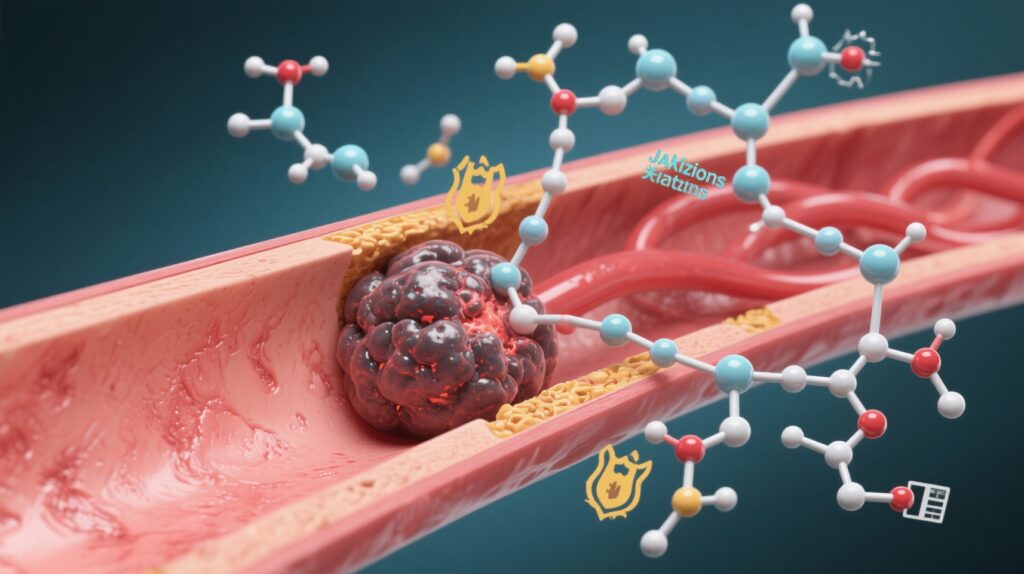Highlight
– JAK inhibitors are associated with a significantly increased risk of pulmonary embolism (PE) and deep vein thrombosis (DVT) compared to dupilumab and methotrexate in patients with atopic dermatitis (AD).
– No significant differences in thromboembolic risk were observed between JAK inhibitors and cyclosporine.
– The study supports a personalized approach to JAK inhibitor use, especially in patients with pre-existing thromboembolic risk factors.
Background
Atopic dermatitis (AD) is a chronic inflammatory skin disorder affecting up to 10% of adults and 20% of children worldwide, with profound impacts on quality of life and substantial healthcare utilization. Moderate-to-severe AD often necessitates systemic immunomodulatory therapy. In recent years, Janus kinase (JAK) inhibitors have emerged as effective oral agents for AD, offering rapid symptom relief and broad immunomodulatory effects. However, accumulating evidence from other immune-mediated diseases has raised safety concerns, particularly regarding thromboembolic events, including DVT and PE. Understanding the comparative safety profile of JAK inhibitors in AD is imperative for optimal patient management.
Study Overview and Methodological Design
The study by Kridin et al. (J Eur Acad Dermatol Venereol. 2025) is a retrospective, global cohort analysis leveraging the TriNetX database, which aggregates anonymized electronic health records from diverse healthcare settings. The investigators conducted three propensity score-matched (PSM) analyses, comparing adults with AD initiating JAK inhibitors versus those starting dupilumab (n = 1006), methotrexate (n = 958), or cyclosporine (n = 948). Matching was based on demographics and comorbidities to control for potential confounders.
Primary endpoints included the incidence of myocardial infarction (MI), stroke, pulmonary embolism (PE), and deep vein thrombosis (DVT) within three years of treatment initiation. The mean age of participants ranged from 41.7 to 43.3 years, with a female predominance (62%) and a racially diverse sample (54% White, 46% non-White).
Key Findings
– JAK inhibitors conferred a significantly higher risk of PE (HR, 2.75; P = .014) and DVT (HR, 2.54; P = .017) versus dupilumab, translating into approximately eight and nine additional cases per 1000 patients, respectively (risk differences: 0.8% and 0.9%).
– The risk of stroke was comparable between JAK inhibitors and dupilumab.
– Compared to methotrexate, JAK inhibitors were associated with a higher risk of DVT (HR, 2.41; P = .017; risk difference: 0.7%), but showed no significant difference for PE, MI, or stroke.
– No significant differences in the 3-year risk of PE, DVT, MI, or stroke were observed when comparing JAK inhibitors with cyclosporine.
The table below summarizes the key comparative risks:
| Comparator | PE (HR, P) | DVT (HR, P) | MI (HR, P) | Stroke (HR, P) |
|—————-|————–|————–|————|—————|
| Dupilumab | 2.75, .014 | 2.54, .017 | NS | NS |
| Methotrexate | NS | 2.41, .017 | NS | NS |
| Cyclosporine | NS | NS | NS | NS |
(NS = Not Significant)
Mechanistic Insights and Pathophysiological Context
JAK inhibitors modulate intracellular signaling of multiple pro-inflammatory cytokines via inhibition of the JAK-STAT pathway. While this mechanism underpins their efficacy in AD, it may also affect endothelial function, coagulation pathways, and immune cell trafficking, potentially promoting a prothrombotic milieu. Previous studies in rheumatoid arthritis and other autoimmune cohorts have reported similar thromboembolic signals, particularly with tofacitinib and baricitinib. The exact molecular mechanisms remain under investigation but may involve altered balance of pro- and anti-coagulant cytokines and impaired endothelial homeostasis.
Clinical Implications
These findings have direct implications for clinical practice:
– JAK inhibitors should be prescribed with heightened vigilance in patients with moderate-to-severe AD, especially those with known risk factors for thromboembolism (e.g., prior VTE, obesity, immobility, hormone therapy, malignancy).
– Dupilumab, which showed a more favorable thromboembolic safety profile, may be preferred in patients with elevated baseline VTE risk.
– Methotrexate and cyclosporine remain important alternatives, with their own distinct risk-benefit profiles.
– Shared decision-making and individualized risk assessment are essential when initiating JAK inhibitor therapy.
Limitations and Controversies
– The retrospective, observational nature of the study limits causal inference and is subject to potential residual confounding, despite propensity score matching.
– The TriNetX database, while comprehensive, may undercapture events not coded or not captured within participating institutions.
– The study did not stratify risk by specific JAK inhibitor agent, dose, or duration, nor did it explore the impact of additional VTE risk modifiers.
– Absolute event rates remain relatively low (additional 0.7-0.9% per 1000 patients), and the clinical significance must be weighed against therapeutic benefit.
– Prior clinical trials of JAK inhibitors in AD have reported low rates of VTE, raising questions about the generalizability or population differences in real-world versus trial settings.
Expert Commentary or Guideline Positioning
Recent guidelines from the American Academy of Dermatology (AAD) and European Dermatology Forum (EDF) recommend careful patient selection for JAK inhibitor therapy, with baseline and periodic risk assessment for thromboembolic events. Experts advocate for heightened surveillance in populations with pre-existing cardiovascular or thrombotic risk, and consideration of alternative therapies in high-risk individuals. The current study reinforces these recommendations and may prompt further updates as new data emerge.
Conclusion
JAK inhibitors offer a valuable, oral treatment option for moderate-to-severe AD, but carry an increased risk of venous thromboembolism relative to dupilumab and methotrexate. Individualized patient selection, risk stratification, and shared decision-making are critical when considering JAK inhibitors for AD. Ongoing pharmacovigilance and mechanistic studies are warranted to further elucidate the thrombotic risk and optimize patient safety.
References
1. Kridin K, Kridin S, Mayer E, Sawaed W, Ludwig RJ. Cardiovascular and thromboembolic risks of JAK inhibitors in atopic dermatitis: A global cohort study. J Eur Acad Dermatol Venereol. 2025 Jul 21. doi: 10.1111/jdv.20864. PMID: 40689675.
2. Papp KA, Szepietowski JC, Foerster J, et al. Efficacy and Safety of Upadacitinib vs Dupilumab in Adults With Moderate-to-Severe Atopic Dermatitis. JAMA Dermatol. 2023;159(1):46-56.
3. American Academy of Dermatology. Guidelines of care for the management of atopic dermatitis. J Am Acad Dermatol. 2023;88(1):43-62.
4. Ytterberg SR, Bhatt DL, Mikuls TR, et al. Cardiovascular and cancer risk with tofacitinib in rheumatoid arthritis. N Engl J Med. 2022;386(4):316-326.



